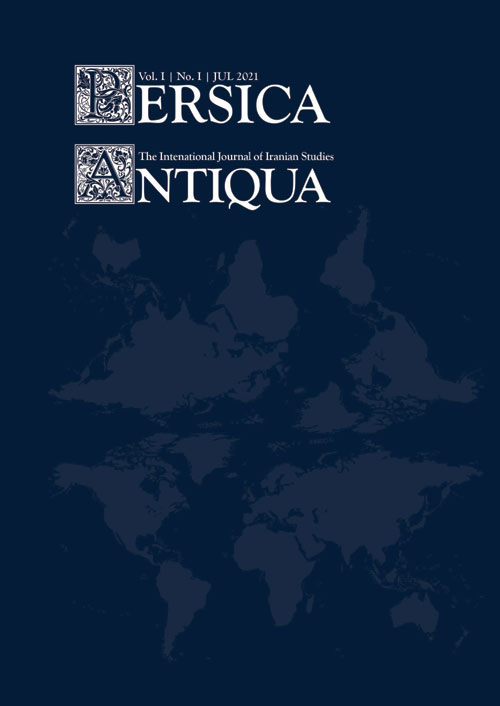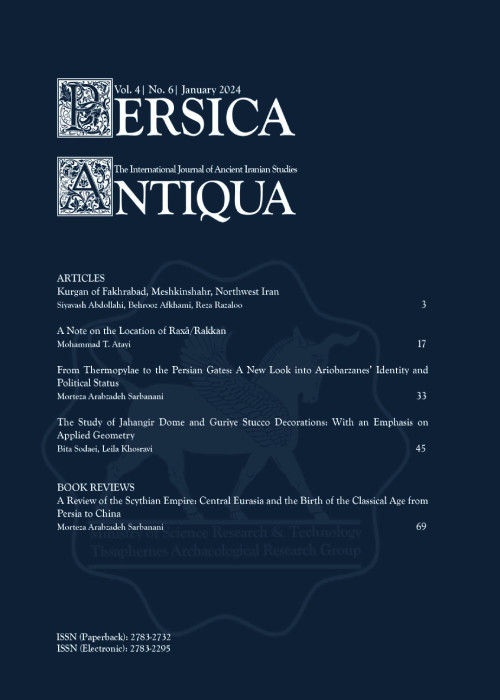فهرست مطالب

Persica Antiqua
Volume:2 Issue: 3, Jul 2022
- تاریخ انتشار: 1401/04/22
- تعداد عناوین: 6
-
-
Pages 3-17A regular hexagon is one of the shapes introduced in Plane Geometry and refers to a hexagon with equal sides wherein the size of each angle is 120 degrees. This geometric shape, which can be quickly drawn today, was constructed over a long period in the millennia BC In the Late Neolithic period in Mesopotamia, the primary geometric shapes, including triangles, quadrilaterals, arcs, and circles, were additionally painted on the surface of pottery ware. Naturally, these shapes had been initially drawn by hand, and the sides of the polygons were not comprised of straight lines, or the circles had not been drawn perfectly. However, in the Chalcolithic age, geometric shapes moved away from handmade forms and approached standard ones. This standardization was not possible without drawing tools. In the meantime, the role of compasses or other objects with a similar use was of utmost importance because drawing a circle with such tools paved the way for drawing regular polygons. In fact, from the Late Neolithic, handmade triangles and arcs in the Near East, the first regular hexagon in the late second or the early first millennium emerged over several thousand years. Constructing this geometric shape with the help of standard circles and arcs has been well documented in the Near Eastern archaeological evidence. On the other hand, regular hexagons have been attributed to the second half of the first millennium in the history of mathematics. Therefore, this study reflected on the construction process of this geometric shape and dated its drawing hundreds of years back.Keywords: Regular Hexagon, Near East, Neolithic, Pottery, Geometry
-
Pages 19-34
Recent field works have shown a great potential of rock art in eastern Iran, particularly in South Khorasan province. This paper is based on recent fieldworks, which have resulted in identifying new clusters of petroglyphs at Birjand. Khazān, Aso, Kāfarkuh and Lākhduldul have been identified in this region. The major technique applied for these petroglyphs is hammering, sometimes rubbing and very rarely engraving. The images at the aforementioned sites include zoomorphs, anthropomorphs and geometric motifs, undiscernible shapes and some inscriptions engraved on boulders. Although a preliminary chronology can be established based on patination and archaeological evidence, we cannot suggest an exact dating for them. Therefore, more fieldworks and micro-erosion analysis will be required for absolute dating.
Keywords: petroglyph, Khazān, Kāfarkuh, Lākhduldul, Birjand, East Central Iran -
Pages 35-52Rudbar, located in the south of Gilan, on both sides of the Sefid-rud River, is a mountainous and one of the ancient regions dating back to at least 200,000 years ago. The artifacts obtained from Darband- Rashi Cave, Marlik Hill, Caluraz, Halimehjan, etc. indicate the existence of ancient civilizations in this region, each of which has its own cultural characteristics. Shemam is one of the old villages with a rich cultural history in the highlands of South Rostamabad. The first archeological excavations in this village were carried out under the supervision of Shahidzadeh in 1970 and a big cemetery belonging to the Parthian period was discovered with slum graves. During the earthquake of 1989, this village was severely damaged and the people living there moved to the lower part and Rostamabad. In recent years, people have resumed building houses on their ancestral estates. During these constructions and the statue, which is accompanied by the supervision of cultural heritage experts of Gilan province, traces of a hand-made structure appeared. Therefore, the construction work was stopped and after issuing a permit from the Cultural Heritage Research Institute of the country, number 4002867, in summer 2021, speculation was made in this area under the supervision of Solmaz Raof. This structure is most likely a grain storage pit dug in the heart of the limestone bed. The wall inside the structure is covered with mud and the floor is covered with beaten mud. Other cultural data obtained from this excavation include pottery pieces. According to comparative study and comparison, most of these pieces are related to the Parthian period.Keywords: Shemam Village, Rudbar, Storage Pit, Parthian, Asian Economy
-
Pages 53-73
Elymais had existed as a semi-autonomous and sometimes autonomous satrap, coinciding with Seleucids and the Parthians in the southwest and west Iran. This government played an active presence in political and economic domains of the region from the mid-second century BC to the advent of the Sasanian Empire. This paper tries to study the historical coins of Elymaean using archaeometry. The method is a valuable criterion for the recognition of size and weight of those coins. Elemental studies of coins give us valuable information in connection with particle size used, combinations percentage of the coins, and applied metallurgy in their manufacturing. In other words, the study provides groundwork for understanding the economic and political structures as well as commercial communications of the society. The difference in the quantity of element may provide information about the mining of these metals. As such bronze and silver coins belonging to the Elymaean have been studied using PIXE technique to know about the concentration of elements, the number of mines as well as mints through the elemental analysis and the definition of the chemical composition of metals. To achieve the mentioned goals, we analyzed 35 coins involving three periods of Elymaean (from 85 BC to 224 AD). The results showed that the percentage of elements in coins such as silver and copper in the three periods were different but have had more purity in the first period. Furthermore, the analyzed coins are minted at six places and raw materials were brought from three different mines. Lastly, the statistical analysis is performed with SPSS software.
Keywords: Elymais Coins, Ore, PIXE technique, SPSS, Elemental Analysis -
Pages 75-99The famous “Shapur Cameo” from the collection of Bibliotheue Nationale is an important object and appears in various studies of Sasanian art, as well as of arms and armour. Studies focus on dating of the object, identification of the scene or identification of the depicted personages without asking the basic question whether the cameo is surely genuine. The conclusion of the article is that the arguments pointing to its nineteenth century origin prevail. It must be stated that the Sasanian elements are employed in very skilled manner both in terms of composition and majority of depicted details, however indecisive nature of the picture which does not clearly define the victor, unclear clothes or garb of the Persian figure, archaic sword of the Roman figure, his awkward position, and not tied tails of the horses, allow to believe that the person who designed the cameo was not fully aware of Sasanian realia. The Sasanian elements are gathered from the limited range of references. The separate argument is that cameos are not type of art favored in Sasanian Iran.Keywords: Shapur Cameo, Sasanian art, Formal Approach, Sasanian Forgeries, Sasanian Imitations
-
The Preliminary Report on Excavations at Eastern Residential Area of Shahr-i Sokhta: Rooms 27 and 28Pages 101-109Excavation on various parts of the Eastern Residential Area (ERA) of Shahr-I Sokhta with the aim of reaching the most ancient layers of period I began in 2017 (Seyyed Sajjadi and Moradi, 2019: 711). Based on the information obtained from previous excavations (Tosi, 1983), the new ones (1999-2018) as well as different test trenches in ERA between 2018 and 2020 (Moradi, 2022: forthcoming), it seems that the Eastern Residential Area was the main center of the city during the formation of period I of occupation of the site. Rooms 88 and 88a in the western part of Eastern Residential Area were excavated during last seasons. Also Rooms 27 and 28 in the center of the residential area were selected for new excavations, although parts of these rooms were investigated during the last season, from the beginning of December 2020 in a 5 X 4.5 meters square.


